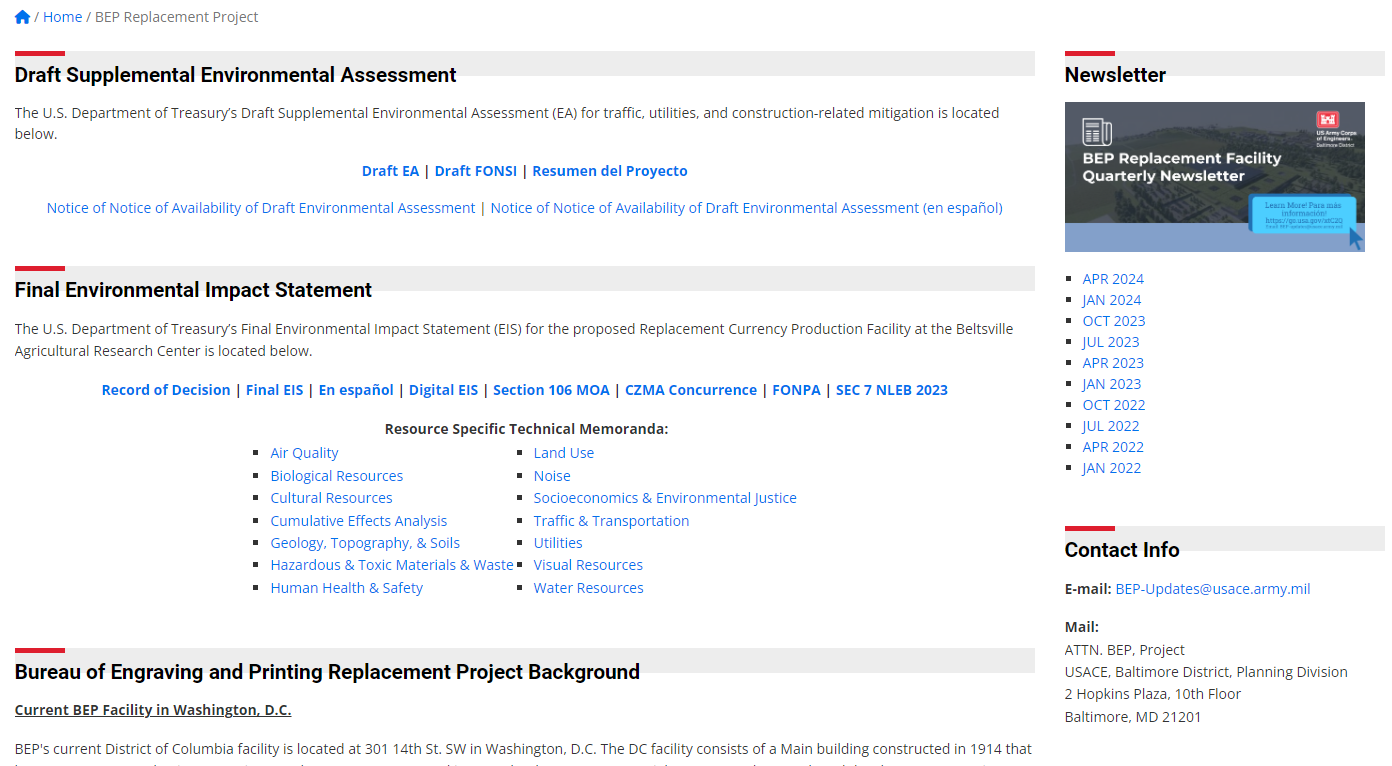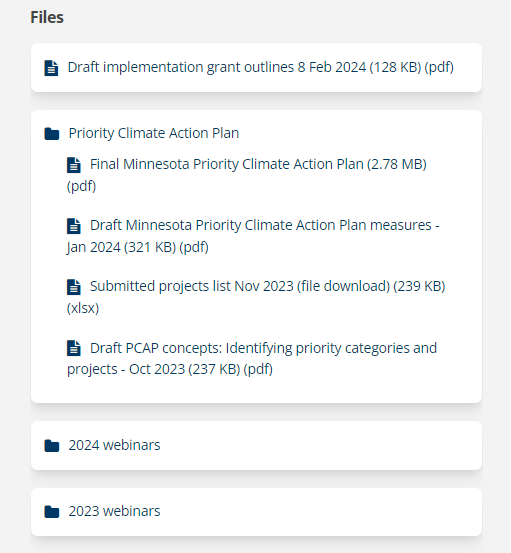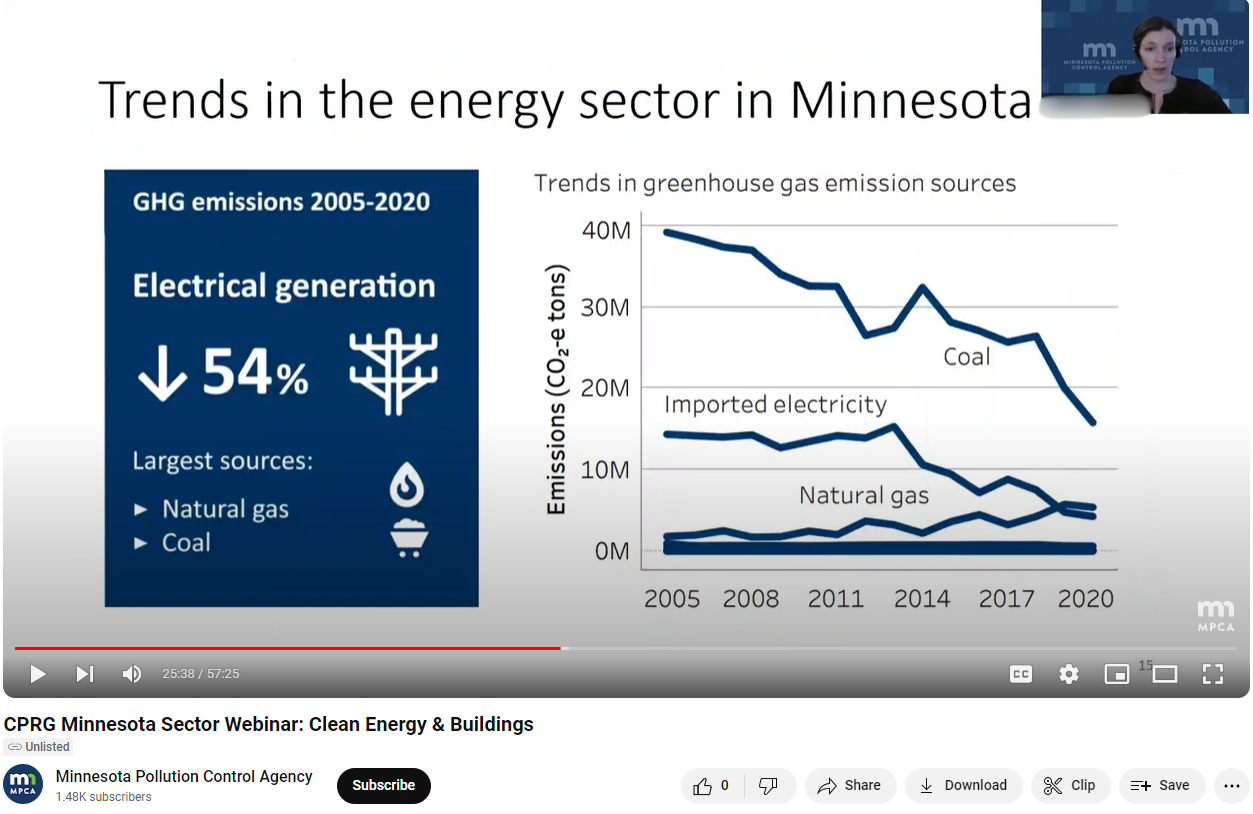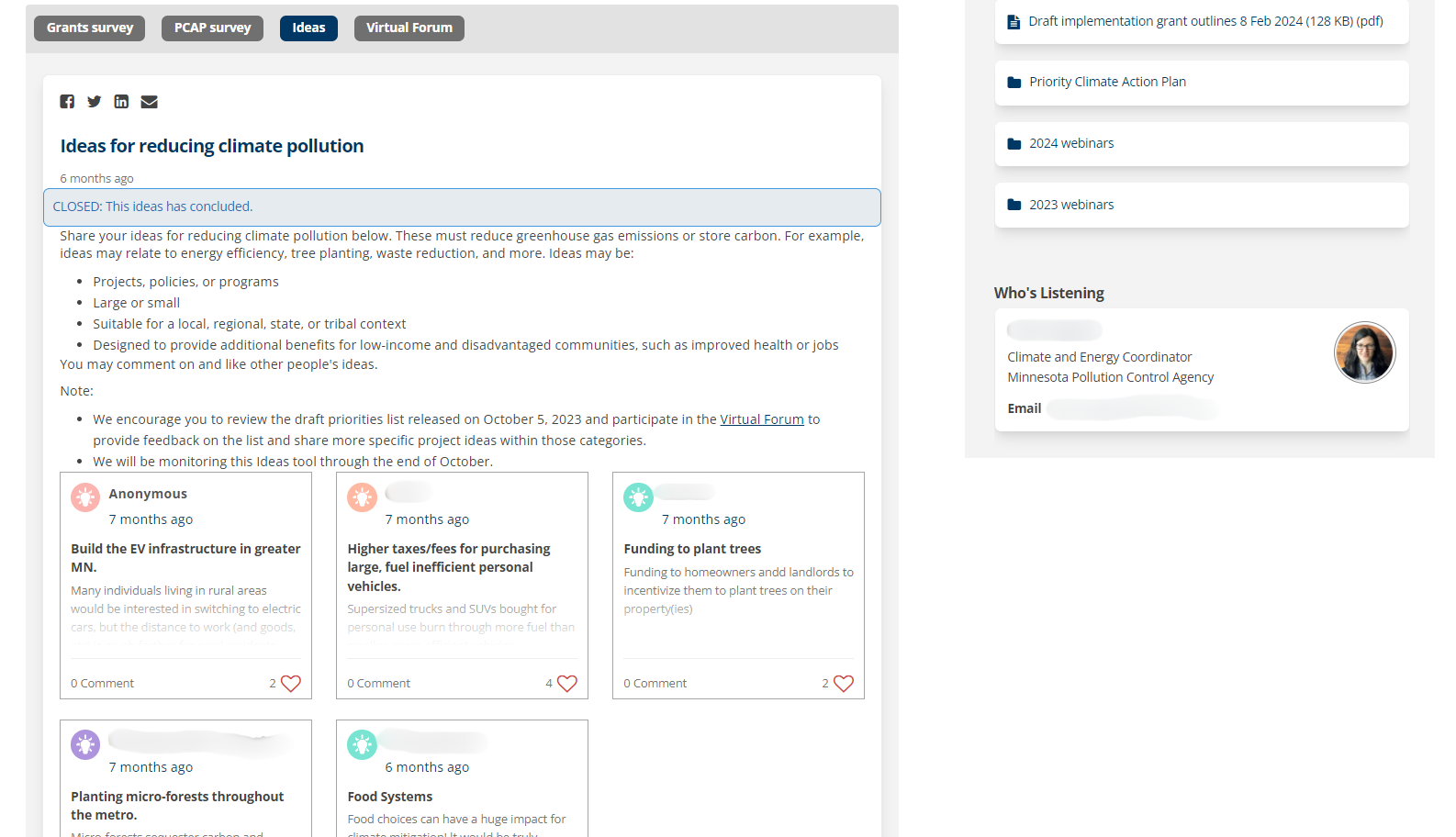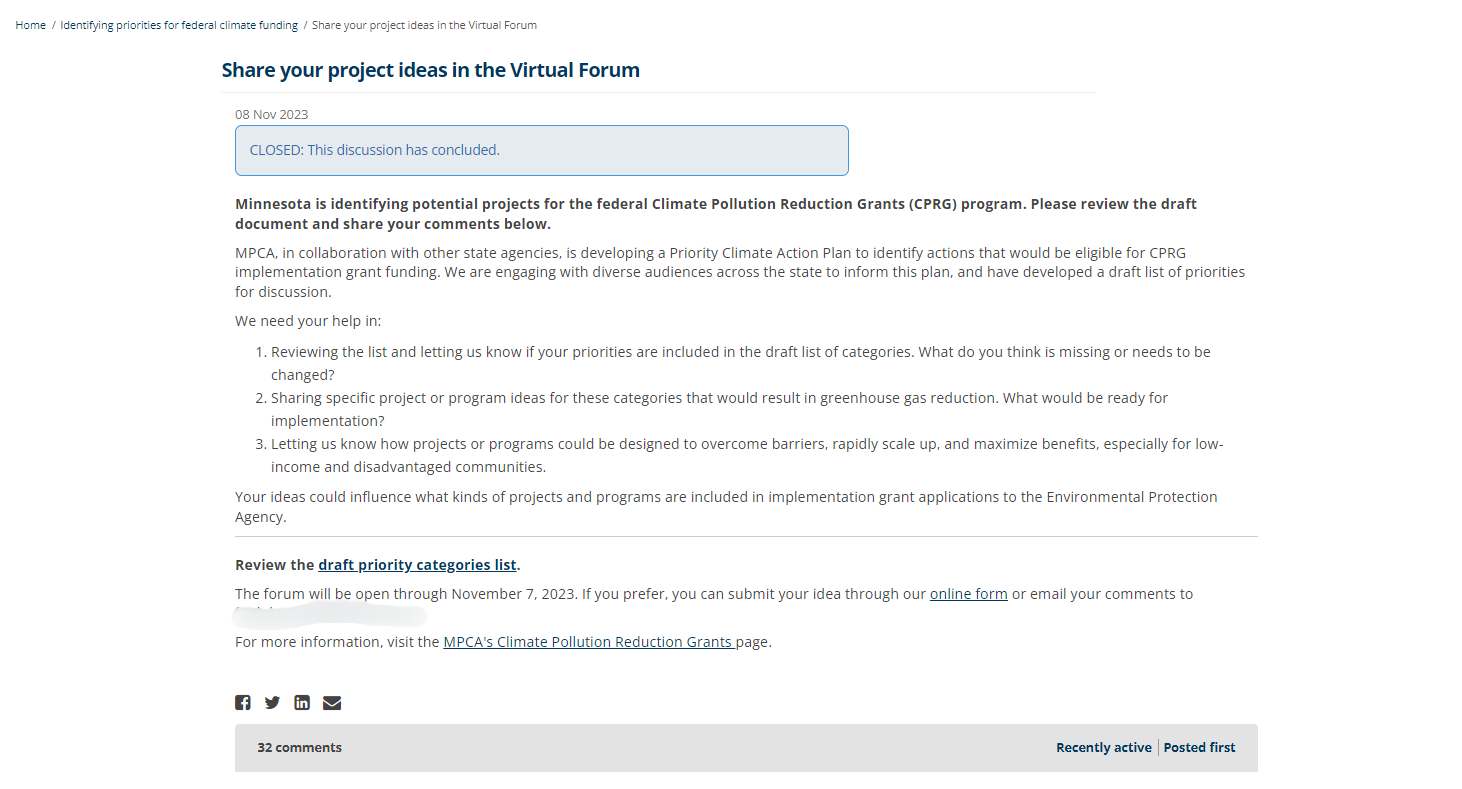flowchart TD
A[Secure Planning Grant] --> B
subgraph B [Develop Priority Climate Action Plan]
B1[Draft a List of Project Categories]
B1 --> B2[Identify Project & Program Ideas]
B2 --> B3[Choose, Refine, and Describe Ideas to Pursue]
end
B3 --> C[Develop Comprehensive Climate Action Plan]
C --> D[Apply for Implementation Grant]
Combined Webtext
In this webtext, we emphasize the importance of deliberative approaches to science communication, especially in contexts where science provides evidence to support decisions. Public engagement in the context of environmental decision making, we argue, is one such context. While scholars in technical communication and related fields have explored public engagement, communication in these spaces is increasingly mediated by emerging digital technologies that warrant further attention.
Toward that end, we provide a brief tour of the ecology of emerging digital tools and artifacts in two recent cases of public engagement. In so doing, we shed light on how these emerging digital technologies are being used to facilitate 1) collaboration among scientists and other technical experts and 2) engagement with citizen stakeholders.
As our examination of emerging technologies in this context illustrates, while technical communication and science communication are each their own interdisciplinary areas of inquiry, technical communication skills and expertise are increasingly relevant to the practice of science communication. We conclude by providing resources and recommendations from the field of technical communication for supporting effective science communication and public engagement.
Intro: Science Communication and Public Engagement
As researchers trained at the intersection of technical communication and the rhetoric of science, technology, and medicine who frequently teach courses in technical communication, we have oftentimes reflected on the boundaries of scientific communication, technical communication, and science communication. Readers might relate to the moment in conversation when an interdisciplinary colleague, a curious student, or a family member assumes these areas are the same or asks how they are different. As we illustrate in this section, the boundaries implied by conventional definitions become quite porous when you move away from prototypical examples toward more common spaces of practice.
Communication: Science, Scientific, and Technical
We might say, for example, that these are three areas of communication that all deal with "complex" subject matter, but are distinguished by their purposes, audiences, and genres. If we were to develop a composite of the most common, high-level distinctions, we might describe each area as follows:
Science communication is commonly understood as communication aimed at nonexpert audiences such as the general public, policymakers, and media, with the goal of making scientific knowledge approachable, enhancing public understanding of science, and influencing decision-making. Prototypical examples of this include Neil DeGrasse Tyson's StarTalk radio program, which discusses complex astronomical phenomena in an engaging way; public science museum exhibits, like those about paleontology that visually explain the prehistoric world; and articles in publications like Scientific American that address current scientific issues such as climate change for broader audiences.
Scientific communication focuses on communicating with peers within the scientific community to advance science through the sharing of research findings and discussion of theories. Typical forms of scientific communication include peer-reviewed research articles that detail new studies and discoveries, presentations at scientific conferences where researchers share and discuss their work, and academic posters that succinctly present research findings at gatherings of experts.
Technical communication is designed for both specialized and nonspecialized audiences, aiming to make specialized information or technology comprehensible and usable. This can include detailed instruction manuals that guide users through the setup and use of devices, comprehensive reports that communicate the results and implications of technical assessments, and thorough documentation such as software user guides or API documentation, which are essential for understanding and effectively utilizing technology.
| Audience | Purpose | Prototypical examples | |
|---|---|---|---|
| Science Communication | Nonexpert or general audiences, including the public, policymakers, and media | Make scientific knowledge approachable; enhance public understanding of science; inform decision-making | Neil De Grasse Tyson's StarTalk; Public science museum exhibit about paleontology; Scientific American article about climate change |
| Scientific Communication | Peers in scientific community | Advance science by sharing research findings, discussing theories | Peer-reviewed research articles, conference presentations, posters |
| Technical Communication | Specialized or nonspecialized users | Make specialized information or technology comprehensible and usable; use technology to communicate specialized information | Instructions, reports, documentation |
While these conventional understandings surely have some utility, the distinctions they rely on are often vague in practice. For example, consider the distinction between scientific knowledge and specialized information: Are the media, policymakers, and citizens not users of the evidence science produces? Does making that specialized information comprehensible and usable constitute science communication or technical communication?
Consider also the notion of peer, specialized, or technical audiences: At what point are researchers in adjacent disciplines or nonacademic organizations no longer peers? Are research articles published in the Journal of Environmental Management, written by ecologists and read by both environmental economists and government natural resource managers, scientific communication or science communication?
Finally, consider definitions of technical communication that hinge on the use of technology: Does the use of communication technology to make information comprehensible and usable position both scientific and science communication as also forms of technical communication?
The bounds of science itself are notoriously difficult to draw (take our word for it, or type "demarcation problem" into your search engine of choice), and we believe the same is true for technical, technology, and expert. At risk of complicating things further, each of the conventional understandings above stage communication primarily as one-way transmission as opposed to dialogue or deliberation. As scholars in the field of writing studies and specifically in technical communication have long held, transmission models of communication tend to rely on misguided "windowpane" theories of language (Miller, 1979; Read, 2022). This stands in contrast to the rhetorical view that all communication—scientific, technical, or science—is participation in a community, part of a socially situated back and forth.
Fortunately, our goal is not to resolve these definitional problems. Rather, we simply wish to disrupt conventional, narrow views of communication in order to make room for two arguments: 1) public engagement with policy making is a site of science communication, broadly construed, and 2) this communicative practice is also productively viewed through the lens of technical communication.
Science Communication in/and/as Public Engagement
Public engagement in policymaking may on its face appear to have little connection to science communication as it's often understood, so in this section we briefly articulate two ways we see public engagement as relevant to science communication.
What is public engagement?
For our purposes here, public engagement refers to the processes and mechanisms by which the public participates in democratic policy or decision-making. As Kristen R. Moore (2017b) suggested, public engagement as we define it here can be formal or informal and optional or mandated. Scholars in a range of fields as well as government practitioners use various terms to describe both public (civic, community, stakeholder, citizen) and engagement (participation, involvement, inclusion, consultation), but generally speaking these are all efforts to improve the transparency, legitimacy, and quality of government decisions through communication between decision makers and those affected by the decisions they make.
In other words, we might see public engagement processes as attempts to enact the ideals of deliberative or participatory democracy, where participation and dialogue are understood as central to good decisions. Formal engagement efforts often fail to achieve such ideals (Blythe, Grabill, & Riley, 2008; Card, 2020; Simmons, 2008), in part due to conflicting views of the relevant scientific evidence in a particular issue or disagreements over the proper roles of "science" and "democracy" in these contexts. That is, there can be a sense that decisions can be made democratically or scientifically, but not both.
Public engagement as a site of science communication
William Keith and Robert Danisch (2014) argued that for John Dewey and Deweyans, science and democracy are flip sides of the same coin: "Science, properly understood, is a democratic enterprise, and democracy is a scientific one" (p. 34). In this view, science involves open inquiry, debate, and collaboration. It isn't controlled by a single authority but rather depends on collective contributions and rigorous examination. Science values diversity of thought, peer review, and transparency—principles that align with those in a democratic society where people can freely express their opinions, challenge authority, and contribute to shared knowledge. Similarly, democracy is a process of continuous inquiry and experimentation, akin to the scientific method. It requires constant examination, questioning, and re-evaluation of policies and systems. Democratic societies rely on evidence-based decision-making, open public discourse, and adaptability in response to new information or changing circumstances. Keith and Danisch's idea that science and democracy are interconnected suggests that both thrive on open communication, inquiry, collaboration, and adaptability.
Taken together, these notions of science and democracy lead directly to Dewey's search for "social democracy"—a "search for the practical and intellectual conditions in which appropriate and timely communicative acts can guide public deliberation, and where public deliberation simultaneously considers both ends/values and means/technologies/knowledge" (Keith & Danisch, 2014, p. 28).
To make this point, Keith and Danisch (2014) distinguished between science1 and science2:
- science1: "the professional practices of those who pursue knowledge, not so much for its own sake but as a professional occupation: scientists, whether 'laboratory' or field scientists or even social scientists" (p. 35).
- science2: "a variety of practices having a strong family resemblance to professional science and its epistemology… [that constitute] a reflective and systematic practice of responding individually or corporately to perceived problems" (p. 35)
Following Keith and Danisch, public engagement is at the very least a process in which the results of science (science1) are communicated to a broader group of stakeholders so that it may inform their action. Put another way, public engagement with policy making is a site in which relevant science is communicated to those involved in making policy with the goal of informing decision making. Indeed, scientists themselves often participate in these processes when their expertise or research are in some way relevant to the decision or policy in question.
More radically, we might also view deliberation properly understood as scientific (science2)—as a process of inquiry where we collectively and systematically define problems and put what we know to work in an attempt to address them. Here, policymakers and other stakeholders are engaging in communication as part of a scientific process. Rather than address problems based on a limited definition of the problem and view of the the relevant evidence, they engage in a deliberative process to collectively define the problem, recruit and weigh evidence, and subsequently design an intervention. In this view, the science in science communication is expanded beyond the common view of scientists as folks in white lab coats and the facts they produce. Rather, science is expanded to include problem-solving activities, activities that from a Deweyan perspective are properly viewed as scientific when pursued in ideal conditions. For example, imagine a small coastal town facing increased flooding due to rising sea levels and stronger storms. Instead of relying on top-down policies, the town organizes a series of public meetings and workshops. Residents, scientists, policy makers, and other stakeholders come together to define the problem and propose solutions.
In the two cases of public engagement that follow, science1 plays a critical role. In the first case, for example, decision makers and other participants must consider what ecologists say about the effects of light and noise on local species when determining the impacts of building a currency production facility. In the second case, deciding how to mitigate the effects of climate change by reducing greenhouse gas emissions requires that decision makers know what contributes to current emissions levels and how different actions are likely to influence those levels, both of which are questions that professional scientists in a range of disciplines have weighed in on. And through the lens of science2, the decision makers themselves are engaged in science and science communication to the extent that they are trying to systematically define and address a social problem.
Technical communication as deliberative experience design
Science communication researchers and practitioners increasingly recognize the need for a dialogic, deliberative approach. There is now widespread agreement that the deficit model of science communication, which relies on one-way transmission of facts, is limited at best and may even be counterproductive (National Academies of Sciences, Engineering, and Medicine, 2017; Simis et al., 2016). The American Association for the Advancement of Science (n.d.) advocated strongly for public engagement with science, arguing that "public engagement can provide a constructive platform for public views to be combined with scientific expertise in decision-making contexts."
Around the same time scientists and science communication researchers began to view public engagement as a constructive platform, researchers in technical communication were arguing that technical communicators could serve valuable roles in these settings. Technical communicators are certainly skilled in navigating complex legal and scientific discourses, but technical communication scholars have articulated more expansive roles (St.Amant, 2018). Stuart Blythe, Jeffrey T. Grabill, and Kirk Riley (2008) illustrated how technical communication scholars can "[support] the inventional activities" of participants, in part by helping to situate knowledge claims and relevant information within complex institutional dynamics (p. 294). Kristen R. Moore and Timothy J. Elliott (2016) suggested public engagement be viewed in part as a critical opportunity for planners to collect data to inform the design of the final project, a view resonant with engagement-as-science2. They advocated viewing engagement processes like the ones we discuss in the remainder of the article as efforts to design "listening infrastructures." Building from this work, Moore (2017b) suggested technical communicators serve a three-fold role of participant, facilitator, and designer of public engagement. Moore positioned public engagement as a form of experience architecture, broadening notions of user experience design to include designing the participatory knowledge-making activites that constitute public engagement (2017a). Drawing on this experience architecture frame, Daniel J. Card (2023) explored how committments to procedural and environmental justice can guide technical communicators.
While technical communication scholars have provided useful ways to conceptualize the work of public engagement, these processes are increasingly mediated by emerging tools and technologies that warrant attention. In the two brief case studies that follow, we explore the practices these tools support, paying particular attention to how communication design facilitates not only information dissemination but meaningful dialogue.
Case 1: Bureau of Engraving and Printing Facility
Our first case focuses on the Bureau of Engraving and Printing's (BEP) efforts to build a new currency production facility. Part of the U.S. Department of the Treasury, BEP proposed building a new plant at the Beltsville Agricultural Research Center (BARC) in Beltsville, Maryland, to modernize equipment, improve efficiency, and enhance worker safety.
This proposal required a comprehensive environmental review under the National Environmental Policy Act (NEPA), which involves public input and an environmental impact statement (EIS) for any federal project that could significantly affect the environment. The public engagement process under NEPA involves two key phases. First, the scoping phase, which BEP initiated in late 2019, involves presenting the proposal and gathering public input on issues such as air quality, traffic, and environmental justice. BEP used various methods to engage stakeholders, including public presentations, fact sheets, and comment opportunities. Following the scoping phase, BEP published a draft EIS in late 2020. During the subsequent 45-day public review and comment period, stakeholders could submit comments through various channels, including email, the project website, and a public webinar. These comments were used to shape the final EIS, published in June 2021, with a 30-day public review period before the final decision in October 2021.
BEP's public engagement efforts during these two key phases—scoping and EIS preparation—is our focus in this case. In the sections that follow, we will provide a tour of the emerging digital tools used in the public engagement process.
Project Website
At the outset of BEP's NEPA process, a project website went live to provide an ongoing site of engagement. The project site is a single page with no navigation bar but has many subsections designed to provide additional context and links to supporting information. For example, there is a section on public scoping that includes links to the public scoping report and digital versions of the presentation slides, posters, and factsheets that were used during scoping. Information about the current phase of the project is featured prominently at the top along with links to the materials most relevant to that phase. For example, during the comment period on the draft EIS, links to the digital EIS and virtual reading room were prominently featured at the top of the landing page. In total, the project page currently features well over 100 links organized around six major sections, some of which feature collapsible subsections.
Virtual Reality Reading Room
Another digital tool that supported public engagement during EIS preparation was a VR-based "virtual reading room." Billed as a COVID accommodation, press releases and white papers promised that this VR-driven tool in combination with the GIS-driven tool we will discuss in the next section are the future of NEPA-mandated public participation: "These modern technologies reduce internal NEPA review times, increase meaningful public involvement, improve agency decision making, and focus on improved environmental outcomes, while achieving the proposed action's purpose and need" (AECOM, n.d.).
The virtual reading room is visually laid out to replicate the open-house-style poster session that it replaced. It's essentially a series of topical one-page summaries, with links to supporting materials and ways to submit a comment.
After clicking the link on the project website, participants are taken to the virtual reading room. The room has skylights, brick walls, and wooden floors. Virtual people of varying ages and races and wearing primarily professional attire are positioned throughout the room, looking at the ten large posters that ring the edge of the room. The posters are numbered sequentially, with the first "welcome" poster having a pulsing "start here" icon above it. Participants can click on the posters, which enlarges them and displays them as a one-page PDF on the screen. In the PDF view, participants can click to advance through all the posters. Participants can also exit the PDF view and rotate the virtual room to navigate to a specific poster.
In the center of the room is a table with three clickable objects sitting on it. On the right is a laptop that takes participants to the digital EIS. In the middle is a paper booklet that takes participants to the traditional draft EIS. On the left are three black filing boxes that link participants to various technical memoranda.
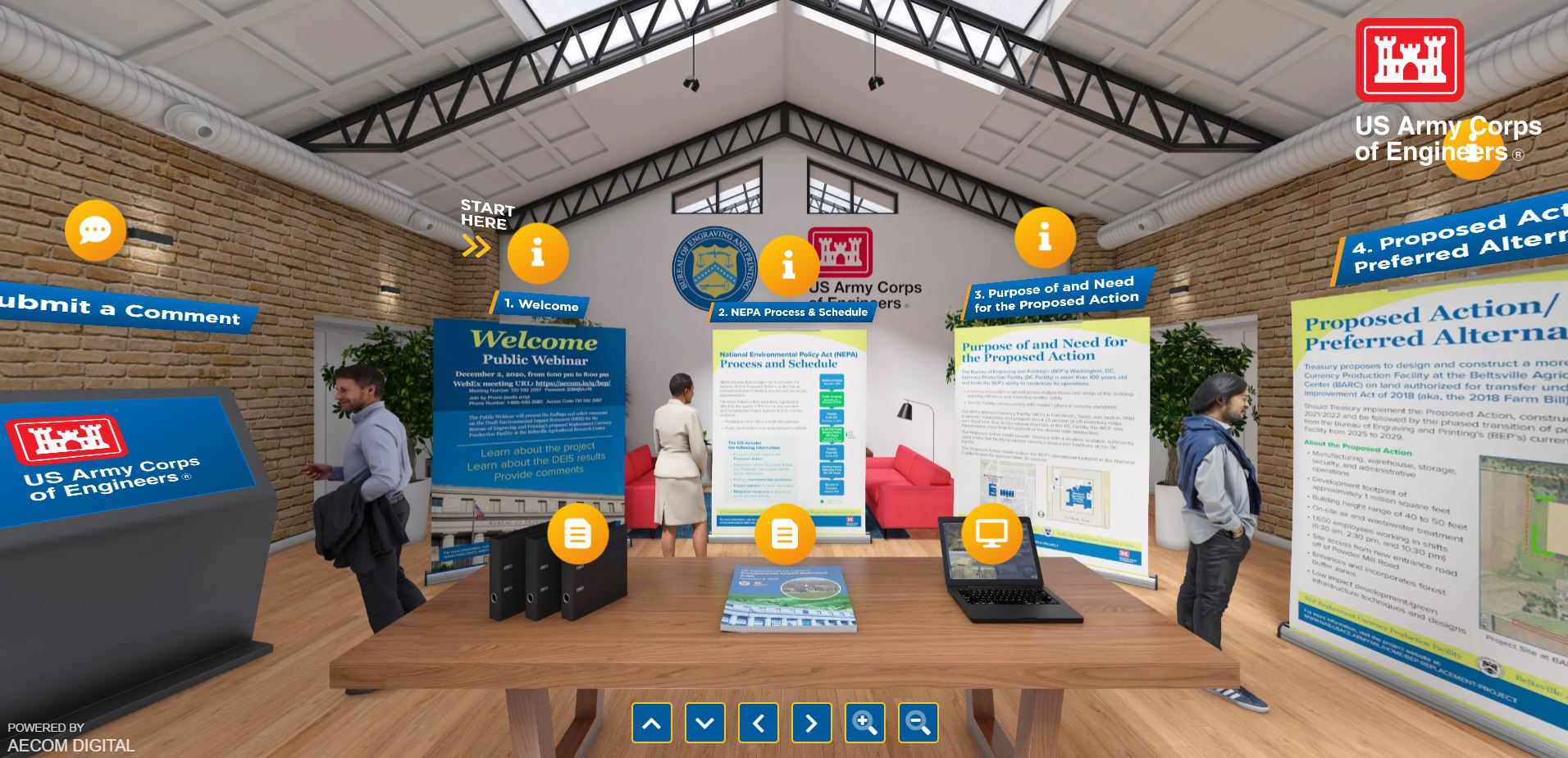
Between the first and last posters, there is an image of a large touch screen for collecting public comments. When participants click on it, they are presented with three options for providing feedback. Participants can click on the first button to email a comment. The second button allows participants to provide a comment through the project website. The third button downloads a comment form.
Digital EIS
Another central digital tool that supported public engagement during EIS preparation was a GIS-driven "digital EIS." Developed in collaboration with the engineering consulting firm AECOM, the digital EIS provided "an interactive, web-based, fully navigable experience for stakeholders and decision makers to visually understand the proposed action" (AECOM, n.d.). This tool modularized the written EIS and technical memoranda, and supplemented them with interactive maps. It has a similar look to Esri's "story maps."
The landing page for the digital EIS provides high-level data on the right half of the screen and photos of the current and proposed sites on the left. Clicking the start button takes participants to the abstract. In general, the digital EIS is organized in the same way that a traditional EIS is (e.g., executive summary, purpose, need, proposed actions, alternatives, resource analyses). In the text on the right side of the screen, there are internal links that let participants drill down on specific topics and connect to the traditional EIS and other project documents. As participants scroll through the text on the right side of the screen, the visuals on the left side change. These visuals include photographs, GIS-maps, drone videos, and analytics.
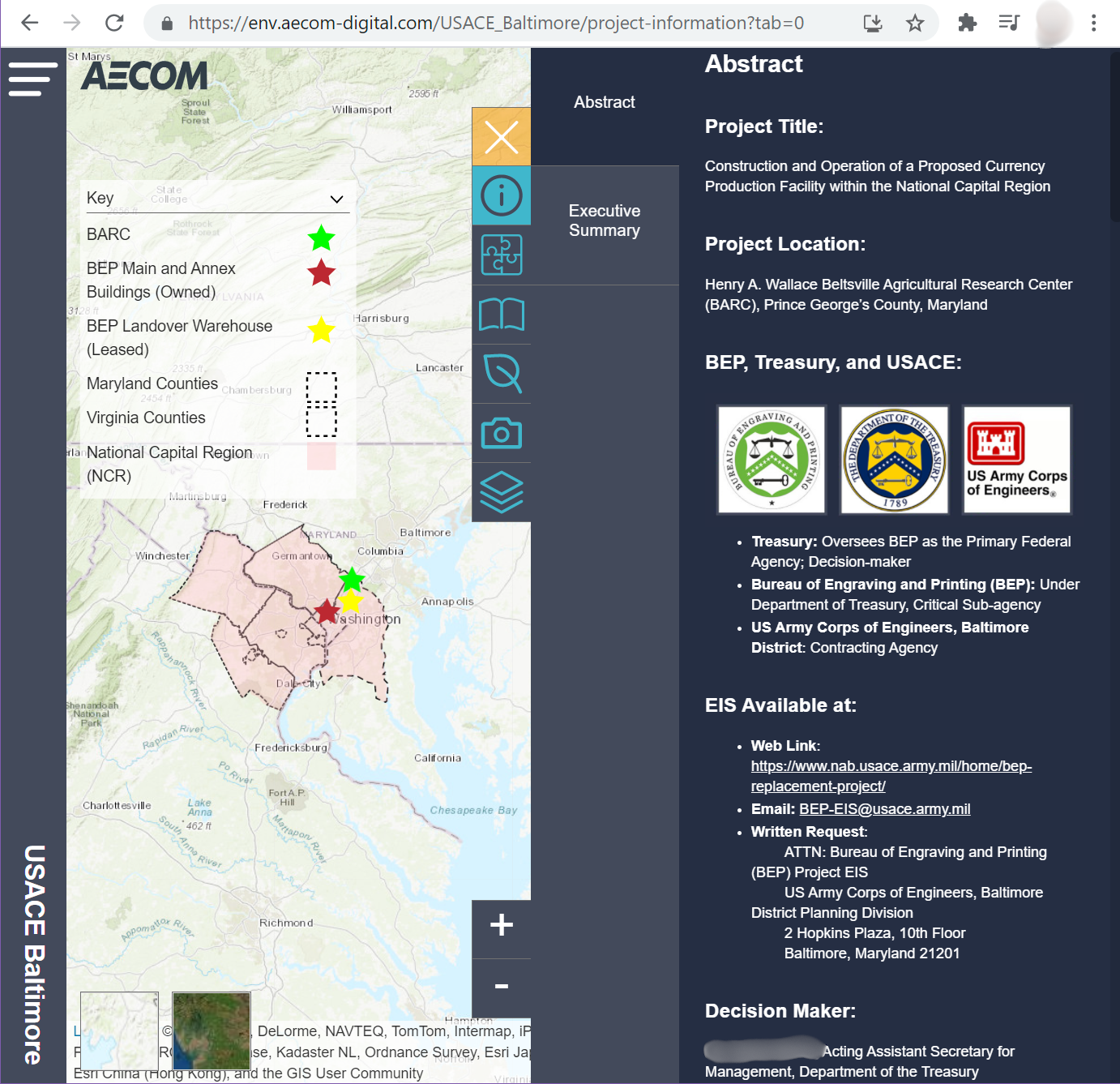
Overall, we see BEP using these digital tools to primarily provide participants with voluminous information in a variety of formats by which they can build their own knowledge about the project. The tools also provide opportunities to collect public comments about the proposed action, alternatives, potential environmental impacts, and recommended mitigation measures. Ostensibly, this allows participants to share relevant information that will potentially shape the outcome, but it's unclear the extent to which that happens in practice.
In other words, this case illustrates how science or technical communication in public engagement contexts requires more than just making scientific information available and approachable. The digital tools employed demonstrate the technical communication challenges of designing spaces that not only present complex environmental impact data, but also support meaningful stakeholder participation in the decision-making process. While the virtual reading room and digital EIS promise to "revolutionize public engagement," their effectiveness as spaces for dialogue and deliberation—key aspects of both science2 and democratic engagement—remains limited.
Case 2: Minnesota Climate Action Planning
Our second case focuses on the Minnesota Pollution Control Agency's (MPCA) efforts to design and fund a climate pollution reduction project. As part of the Inflation Reduction Act, the U.S. Environmental Protection Agencies's Climate Pollution Reduction Grants (EPA CPRG) program was a $5 billion investment that provided states, local governments, and Tribal Nations with resources to implement projects that reduce greenhouse gas emissions and other harmful air pollution (Minnesota Environmental Quality Board, n.d.). In collaboration with other state agencies and stakeholders, the MPCA secured a planning grant in June 2023. The deliverables for this grant included a "Priority Climate Action Plan" (PCAP) that provided "a focused list of near-term, high-priority, implementation-ready measures to reduce climate pollution from greenhouse gas emissions" (Krogstad et al., 2024, p. 8).
The PCAP included a list of projects the agency would be ready to implement. Submitting the plan made the MPCA eligible to apply for an implementation grant, which would provide funding for one or more projects identified in a Priority Climate Action Plan.
The MPCA's process for writing that action plan is our focus in this case.
More specifically, we focus on the MPCA's engagement activities as implemented via a project-specific EngagementHQ webpage dedicated to “Identifying Priorities for Federal Climate Funding.”
Engagement HQ
EngagementHQ is a digital platform designed primarily for use by government agencies. The "all-in-one digital engagement platform" consists of a suite of features designed to help agencies plan and manage community engagement activities. Product descriptions and case studies of EngagementHQ emphasize its ability to promote two-way dialogue, using phrases like deliberative dialogue, open discussion, civil debate, conversation, and co-design (Granicus, n.d.).
EngagementHQ serves as something akin to a content management system where government communicators can design and facilitate communication. Agency communicators can provide project context on the landing page for the project. In this case, the landing page serves as a hub for the MPCA's efforts to secure a CPRG from the EPA.
The top of the landing page features text describing the details of the grant program, what the agency has already done, and what will happen next in the project. At the end of this text, readers are invited to sign up for email updates about the project or email a coordinator directly if they have questions. Links to share the page via email or popular social media platforms are also featured.
To the right, a graphic representation of the project lifecycle lists phases of the project and the estimated timeframe for each phase. Checkmark icons indicate which phases have been completed. Together, the project overview text and lifecycle panel provide high-level project context to orient participants.
A files repository allows government communicators to provide in-depth information and additional background. A files panel below the project lifecyle features a list of materials, including video recordings and associated slides from a series of webinars in which project facilitators provided project information and answered participant questions. These webinars in the file repository serve as a digital alternative or supplement to public meetings where project facilitators might brief community members on the project and seek input. In this case, these webinars serve as key moments to frame subsequent engagement around a set of shared, salient facts.
These webinars serve as a digital alternative or supplement to public meetings where project facilitators might brief community members on the project and seek input. In this case, these webinars serve as key moment to frame subsequent engagement around a set of shared, salient facts.
In addition to providing data, the agency directs participants to data sources they believe will be compelling to the funding agency. For example, they note that the EPA reviewers expect projects to have a positive impact on disadvantaged communities, as defined by Justice40 Initiative criteria and the Inflation Reduction Act's Disadvantaged Communities Map (Council on Environmental Quality, n.d.; EPA, 2023).
Participants are directed to access maps of disadvantaged communities in Minnesota via EJScreen, the EPA's Environmental Justice Screening and Mapping Tool (EPA, n.d.).
(Note: As of 2025, EJScreen has been removed from the EPA website. Public Environmental Data Partners [2025] has reconstructed an unofficial copy of Version 2.3 of the tool.)
Additional files are added throughout the project, such as an outline of potential ideas early in the project and a draft of the PCAP.
Survey
The MPCA used the survey feature to collect data on values and preferences to ostensibly inform which projects they move forward with and provide empirical support for those choices. They opened a survey to gather project ideas within the priority categories they identified. As they articulated in the final action plan, this "survey garnered over 350 submissions from local governments, community-based organizations, state agencies, academic institutions, businesses, and interested individuals, spanning from general ideas to detailed project proposals. These proposed projects… helped inform the measures that are now integrated into the PCAP" (Krogstad et al., 2024, p. 17).
Ideas Board
The team also used an "ideas board" to invite participants to share their ideas for reducing greenhouse gas emissions.
Unlike a survey response that goes directly to the MPCA, short "ideas" were posted to the board and become cards in a grid for other participants to read, like, share, or respond to.
Forum Board
The team also used a "forum board" to invite participants to share ideas. While the prompt was similar to the ideas board, this format was presumably better suited for more involved posts. Here again, participants were able to respond to others' posts.
Overall, we see the MPCA leveraging the features of EngagementHQ not only to provide participants with information in a variety of formats but also to facilitate exchange among participants. Beyond simply sharing climate science data, the platform's features support the collection of local knowledge and facilitate dialogue among stakeholders—essential elements of science2 as described by William Keith and Robert Danisch (2014).
Discussion: Designing Spaces of Engagement
While science communication is often discussed as an effort to make complex, scientific concepts more approachable for "lay" audiences, we propose viewing science communication as essentially an effort to make what an expert community knows available, approachable, and actionable for those outside that expert community, within a new rhetorical context. This view shifts the audience of science communication from passive receivers of information to active participants with goals and contributions. In this sense, this perspective aligns science communication with our notion of technical communication, where the primary focus is not merely to make information approachable but to create the conditions that allow people to address problems (Simmons & Zoetewey, 2012).
In the two cases of public engagement we've discussed, each of the digital tools seem designed to provide stakeholders with additional ways to access information. In a broad sense, these artifacts certainly allow more people to access project information and subsequently participate (even if superficially) in the decision-making process than physical meetings alone. For example, as a web-based artifact, BEP's digital EIS makes use of linking to provide access to a wealth of data; it also makes use of GIS to incorporate information-rich, interactive maps that are not typically part of traditional EISs. Relevant agencies and representatives at the state and local levels are likely to appreciate having remote access to all that data alongside the modularized written content that the digital EIS provides. For some citizen participants, the visual format might be easier to engage with or more relevant than a 100–1,000-page technical report. The infrastructure firm that designed the platforms for both the digital EIS and virtual reading room said the technologies will improve stakeholder engagement by "presenting highly technical information in a user-friendly online and interactive format… [leading] to improved outcomes for communities worldwide" (AECOM, 2020).
Of course, making specialized information available and more approachable for a variety of audiences via digital tools is certainly important; however, it does not necessarily empower stakeholders nor does it guarantee of improved outcomes (Blythe, Grabill, & Riley, 2008; Card, 2020; Grabill & Simmons, 1998; Simmons, 2008; Simmons & Grabill, 2007). We agree with Dave Clark (2007), who suggested that "empowerment is, of course, far more complex than simple access to information" (p. 157). Indeed, a closer look at the events and artifacts that facilitate public engagement in the BEP case (e.g., the webinar, the virtual reading room, the reports to be reviewed) suggest primarily one-way conversations in which information is being delivered. For example, consider the virtual reading room: an online, interactive space that visually approximates a poster session. Created as part of an effort to provide "stakeholders with a safe and effective way to understand the proposed project and provide input despite social distancing requirements," the virtual reading room is visually rich, available 24/7 with internet access, and mobile-friendly (AECOM - Environmental Services, 2021). While the amount of information a viewer has access to is extensive, the virtual reading room doesn't replicate the most important function of a poster session or open house—dialogue with humans.
The use of forums and idea boards in EngagementHQ have more potential to facilitate dialogue. Rather than provide participants with a digital comment box, these tools allow agency managers to create a space where participants can share information and express preferences to the agency as well as to fellow stakeholders. Across these forum comments and ideas, we see invested individuals and stakeholder organizations not only posting ideas but also substantiating with data both the problem their idea responds to and the efficacy of the solution. The MPCA has more flexibility in this context than in the NEPA-mandated review of the BEP impact statement, so we make this comparison not to pass judgement but rather to draw attention to the varied rhetorical functions these tools support. While it is difficult to replicate a design charrette, card sorting activity, or World Cafe in a digital, asynchronous modality, we see in EngagementHQ/MPCA an attempt.
Public engagement is often viewed as being more about questions of value and action than questions of fact—as the place of politics, not science. Yet, we contend that both planners and participants make and contest arguments about what we ought to do based on the questions and answers of science. Further, Moore and Elliot's contention that public engagement is at least in part about gathering data of participants values, preferences, and tacit knowledge positions the entire process as science2—as doing democracy scientifically. Through this lens, the MPCA's use of a survey is not only a mechanism to solicit ideas from stakeholders, but also to collect data on their values, preferences, and perceptions. Following Kristen R. Moore (2017), we contend the engagement planner-as-technical communicator is tasked with not only providing participants with relevant scientific information but also with designing a space in which relevant science can effectively inform decisions—a space in which data is shared but also engaged, evaluated, and created.
Conclusion
In this webtext, we have tried to broaden notions of both science and communication. We suggest viewing science not merely as a set of facts associated with fields such as biology or physics but rather as a systematic problem-solving practice. This shift broadens what we communicate about when we engage in science communication. At the same time, we push against unidirectional, transmission notions of communication in favor of a deliberative frame that privileges dialogue. From this view, the challenge of science communication is to create the conditions for informed dialogue. Taken together, we argue that these notions of science and communication position public engagement as a significant site of science communication.
Further, our examination of the digital tools and modes that mediate such communication suggests the core practices and skills of technical communication are central to public engagement work. And we aren't alone. Consider the U.S. Public Participation Playbook (n.d.). The playbook consisted of a list of 12 "plays" organized around five foci: establish goals, understand the playing field, design participation, facilitate participation, and evaluate and report. Each play consisted of a checklist of recommendations that government managers should follow. For example, "Design Participation" included the plays "Design for inclusiveness" and "Provide multi-tiered paths to participation." The checklist for the former included "Provide accessibility options for persons with disabilities, the aging population and others" as well as "Consider both online and offline support, including a physical version and digital package."
Technical communication research and practice offers valuable insights into effectively conveying complex information to both specialist and nonspecialist audiences as well as designing goal-oriented digital spaces. We find it particularly interesting that many specific recommendations in the U.S. Public Participation Playbook align closely with key areas of focus in recent technical communication scholarship. Below are some examples of these recommendations, along with a selection of relevant work in technical communication:
- Create personas of target participants to understand their needs (Getto & Flanagan, 2022; McMullin et al., 2021; Rose & Tenenberg, 2018).
- Talk to underrepresented members of communities; Recognize common dynamics when cultures interact and develop adaptations to service delivery (Acharya & Dorpenyo, 2023; Gonzales, 2022; Rose, 2016).
- Determine paths for participation and their requirements, such as accessibility, commenting, and annotation (Cagle & Herndl, 2019; Moore, 2017a, 2017b; Rose & Cardinal, 2021).
- Use plain language (Cheung, 2017; Jones et al., 2012; Jones & Williams, 2017; Willerton, 2015).
- Test your content (Kim, 2023; O'Keeffe & Walls, 2020; Richards, 2015).
While science communication is increasingly recognized as an area of interdisciplinary research in its own right, technical communication and writing and rhetoric studies more broadly have much to offer, especially when we look to the spaces where science meets values to inform action.
